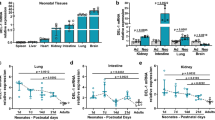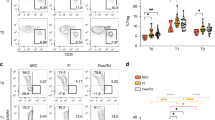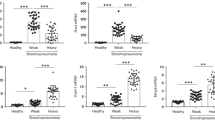Abstract
OBJECTIVE:
Eosinophilia is common among premature neonates, but little is known about the cytokines responsible for influencing its onset in neonates. In adults and transgenic mice, granulocyte-macrophage colony-stimulating factor (GM-CSF) and interleukin-5 (IL-5) influence the development of eosinophilia. We sought to prospectively determine whether these cytokines correlated with the development of eosinophilia in premature infants.
STUDY DESIGN:
We measured the absolute eosinophil count (AEC) and serial serum concentrations of GM-CSF and IL-5 in premature neonates with eosinophilia.
RESULTS:
Among 201 premature neonates, 21 had an eosinophil count of >700/μl (occurrence, 10.5%). Of these 21 neonates, 4 had mild (700/μl to 999/μl), 13 had moderate (1000/μl to 2999/μl), and 4 had severe (>3000/μl) eosinophilia. No differences in gestational age or age at onset of eosinophilia were observed between the groups, but the duration of eosinophilia was less with mild than with moderate or severe eosinophilia. A total of 20 of the 21 patients had an infection or necrotizing enterocolitis diagnosed within 48 hours of the onset of eosinophilia. In patients with mild and moderate eosinophilia, serial GM-CSF and IL-5 concentrations were below the lowest enzyme-linked immunosorbent assay standard. There was no correlation between AEC and GM-CSF or IL-5 concentration in these infants. However, in one patient with severe eosinophilia, two distinct elevations in IL-5 were noted (34.6 and 46.0 pg/ml); each peak occurred 7 to 8 days before a peak in eosinophil count.
CONCLUSION: Eosinophilia is relatively common, and in those neonates with the highest AECs, the duration of eosinophilia can last for >6 weeks. The majority of cases of eosinophilia occurred in temporal proximity to an infectious illness or necrotizing enterocolitis. Serum concentrations of IL-5 were elevated in only one of our patients with severe eosinophilia.
This is a preview of subscription content, access via your institution
Access options
Subscribe to this journal
Receive 12 print issues and online access
$259.00 per year
only $21.58 per issue
Buy this article
- Purchase on Springer Link
- Instant access to full article PDF
Prices may be subject to local taxes which are calculated during checkout
Similar content being viewed by others
Author information
Authors and Affiliations
Additional information
This work was supported by Grants HL-44951, HD-01180, and RR-00082 from the National Institutes of Health, a by grant from the Children’s Miracle Network Telethon, and by a grant from the American Academy of Pediatrics Resident Research Program
Rights and permissions
About this article
Cite this article
Calhoun, D., Sullivan, S., Lunøe, M. et al. Granulocyte-Macrophage Colony-Stimulating Factor and Interleukin-5 Concentrations in Premature Neonates With Eosinophilia. J Perinatol 20, 166–171 (2000). https://doi.org/10.1038/sj.jp.7200332
Published:
Issue Date:
DOI: https://doi.org/10.1038/sj.jp.7200332
This article is cited by
-
Response to Drs Gordon and Clark
Journal of Perinatology (2011)



